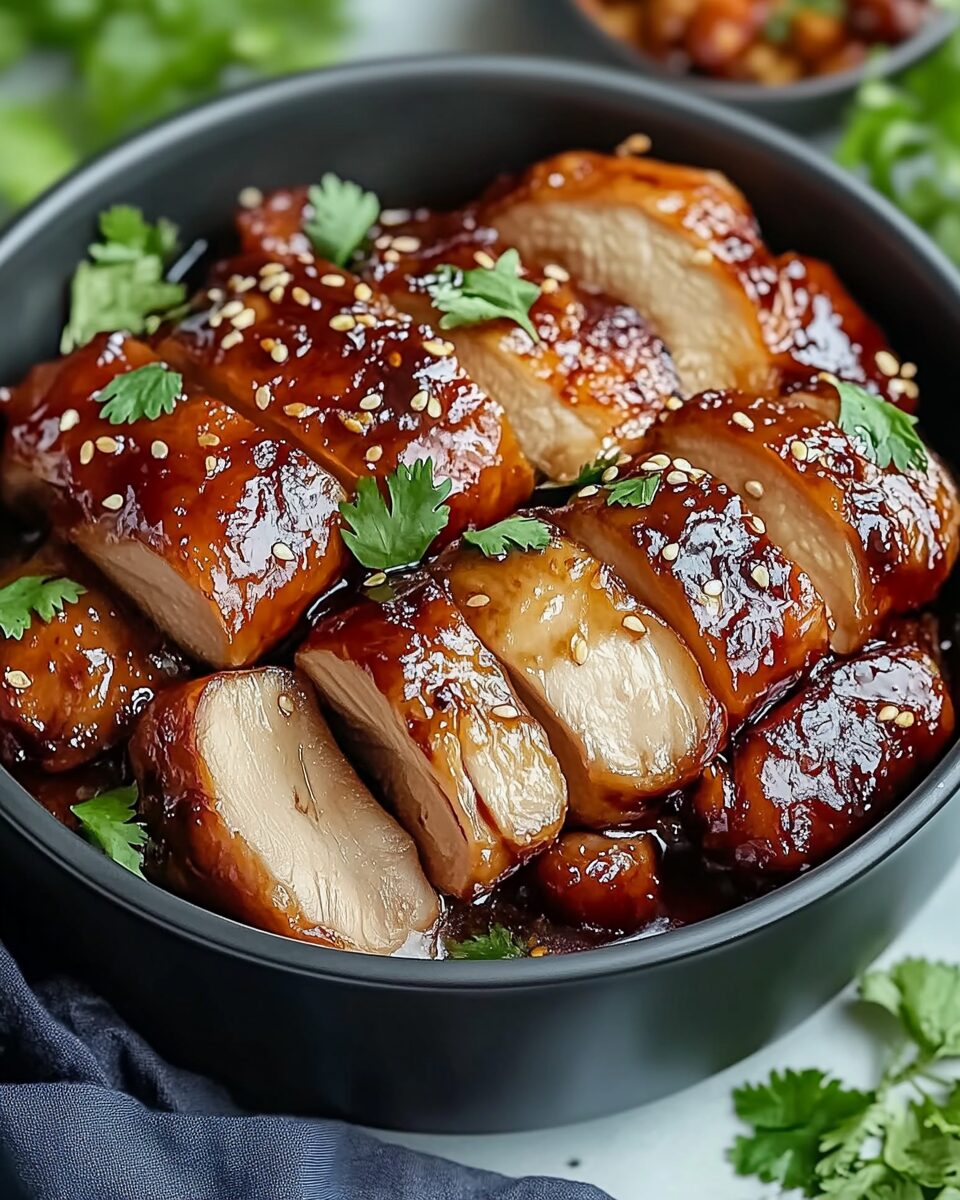Char Siu Chicken is a flavorful and aromatic dish that brings the essence of Chinese barbecue into your kitchen. Traditionally made with pork, this chicken version offers a leaner alternative without compromising on the signature sweet and savory glaze. Perfect for dinner, this dish pairs wonderfully with steamed rice and vegetables, making it a satisfying meal for any occasion.
Full Recipe:
Ingredients
- 2 pounds boneless, skinless chicken thighs
- 2 tablespoons hoisin sauce
- 2 tablespoons soy sauce
- 2 tablespoons honey
- 1 tablespoon oyster sauce
- 1 tablespoon rice vinegar
- 2 cloves garlic, minced
- 1 teaspoon Chinese five-spice powder
- ½ teaspoon sesame oil
- ½ teaspoon red food coloring (optional)
Directions
-
Prepare the Marinade: In a mixing bowl, combine hoisin sauce, soy sauce, honey, oyster sauce, rice vinegar, minced garlic, Chinese five-spice powder, sesame oil, and red food coloring (if using). Mix well until all ingredients are thoroughly combined.
-
Marinate the Chicken: Place the chicken thighs in a large resealable plastic bag or a shallow dish. Pour the marinade over the chicken, ensuring each piece is well-coated. Seal the bag or cover the dish and refrigerate for at least 2 hours, preferably overnight.
-
Preheat the Oven: When ready to cook, preheat your oven to 375°F (190°C). Line a baking sheet with aluminum foil and place a wire rack on top.
-
Bake the Chicken: Remove the chicken from the marinade, allowing excess marinade to drip off, and place the thighs on the wire rack. Bake in the preheated oven for 30–35 minutes, turning halfway through, until the internal temperature reaches 165°F (74°C) and the exterior develops a slight char.
-
Caramelize the Glaze: Switch the oven to broil for the last 2–3 minutes. Watch closely to avoid burning. This step enhances the glaze’s caramelization.
-
Serve: Let the chicken rest for a few minutes, then slice into strips and serve hot with steamed rice and vegetables.
Nutritional Facts (Per serving; serves 4)
- Calories: 320
- Protein: 35g
- Carbohydrates: 18g
- Sugars: 15g
- Fat: 12g
- Saturated Fat: 3g
- Cholesterol: 140mg
- Sodium: 900mg
Cultural Origins and Historical Background
The phrase “Char Siu” literally translates to “fork roast” in Cantonese, referring to the original method of skewering long strips of meat and roasting them over an open flame. This traditional Cantonese cooking technique dates back centuries and has its roots in the Guangdong province of Southern China. It became a staple in Chinese roast shops, known for offering various types of roasted meats like duck, goose, and pork.
Historically, Char Siu was enjoyed by workers and royalty alike. Over time, it became associated with celebration and abundance. Its widespread popularity can be attributed to both its rich flavor and its versatility in being served over rice, in noodle soups, or stuffed inside bao (buns). The dish eventually spread through migration and diaspora, adapting to local ingredients and preferences while retaining its essence.
As globalization influenced food culture, Char Siu became a symbol of Chinese culinary heritage abroad. In Western countries, especially in Chinatowns and Chinese-American restaurants, it became a fixture on menus, often served as part of combination platters or over fried rice. Chicken, a widely accessible and adaptable protein, soon found its place as a delicious variant in this culinary tradition.
The Appeal of Char Siu Chicken
Char Siu Chicken appeals to a wide range of palates because it balances sweet, savory, umami, and aromatic elements in one cohesive bite. It carries the caramelized depth of hoisin and soy sauces, the sweetness of honey or brown sugar, the aromatic warmth of five-spice powder, and the nuttiness of sesame oil. Garlic adds pungency, while vinegar offers a subtle tang that cuts through the richness.
Its flavor profile makes it particularly versatile—it can be the star of a main course, an enhancement to other dishes like stir-fries or noodle bowls, or an elegant appetizer when served sliced. It’s also an ideal recipe for meal prepping, as it stores and reheats well, often tasting even better after the flavors have had more time to meld.
For those concerned with dietary needs, Char Siu Chicken is a protein-rich, customizable meal. It can be made with skinless, boneless thighs for maximum flavor or lean breast meat for a lighter dish. Adjustments to sugar content and sodium levels can easily tailor the recipe to specific health goals without sacrificing taste.
Modern Cooking Techniques
Although the traditional Char Siu method involves skewering and roasting over open fire, modern kitchens have adapted it with ease using ovens, grills, and even air fryers. These methods allow home cooks to achieve a restaurant-quality glaze and texture with minimal equipment.
-
Oven Roasting is perhaps the most common approach. The chicken is typically placed on a wire rack set over a foil-lined tray. This allows air circulation for even cooking and easy caramelization of the glaze without sticking.
-
Grilling infuses the chicken with a smoky depth that mimics the traditional charcoal-roasted flavor. A careful eye is needed to prevent burning due to the sugars in the marinade, but the result is highly rewarding.
-
Air Frying is a modern, health-conscious technique that creates crispy edges and succulent meat using minimal oil. It’s fast and energy-efficient, ideal for those with busy schedules.
Regardless of the method, basting during cooking is essential. Layering the glaze builds that characteristic sticky, lacquered finish that makes Char Siu so visually and texturally appealing.
Char Siu Chicken in the Global Kitchen
Char Siu Chicken has not only been adopted worldwide but adapted to fit into diverse culinary contexts. In Malaysia and Singapore, it’s often served with Hainanese-style chicken rice or incorporated into hawker-style noodle dishes. In the Philippines, a variation known as “Chinese-style chicken asado” draws inspiration from the same flavor palette.
In Western fusion cuisines, chefs have explored Char Siu Chicken tacos, sandwiches, and even pizza. This speaks to the dish’s adaptability and enduring appeal. Because of its distinct taste and eye-catching appearance, it also photographs well—making it a favorite among food bloggers and social media foodies.
Moreover, the increasing availability of Asian pantry staples like hoisin sauce, oyster sauce, and Chinese five-spice powder at mainstream grocery stores means that recreating Char Siu Chicken at home is more accessible than ever.
Flavor Profile and Sensory Experience
When you bite into Char Siu Chicken, you’re greeted with a medley of tastes and textures. The outer glaze is sweet and sticky, occasionally with charred bits that offer a smoky, crisp edge. Inside, the meat remains juicy, infused with the savory-sweet marinade.
The five-spice adds layers of complexity. Star anise contributes a licorice-like sweetness; cloves bring warmth; cinnamon adds depth; Sichuan pepper lends a subtle tingle; and fennel gives a mild sweetness reminiscent of aniseed. Together, these spices elevate what could be a simple sweet sauce into something aromatic and deeply flavorful.
Health and Nutrition
Char Siu Chicken, especially when made at home, can be a nutritious and balanced part of your diet. Chicken is a high-quality source of lean protein, essential for muscle maintenance and growth. Using skinless cuts can significantly reduce the fat content.
Tips for Perfecting the Dish
-
Marinate Overnight: Deep flavor penetration occurs when the meat is allowed to soak in the marinade for several hours or overnight.
-
Reserve Some Marinade for Basting: To avoid cross-contamination, set aside a portion before marinating the chicken. Use it during cooking to develop that sticky, glossy finish.
-
Avoid Overcooking: Use a meat thermometer to ensure the chicken reaches an internal temperature of 165°F (74°C). This keeps it juicy and prevents drying out.
-
Rest Before Slicing: Let the meat sit for 5–10 minutes after cooking. This helps retain juices and makes slicing easier.
-
Use a Wire Rack: Elevating the chicken during baking allows heat to circulate and helps caramelize the exterior without stewing in its juices.
Presentation and Serving Ideas
Presentation enhances the experience of eating Char Siu Chicken. Thinly sliced pieces arranged over steamed rice, drizzled with a little leftover glaze, create a stunning and appetizing plate. Garnishing with chopped green onions or sesame seeds adds color and a hint of crunch.
Conclusion
Char Siu Chicken is much more than a delicious recipe—it’s a reflection of culinary adaptability, cultural richness, and timeless flavor. Its ability to evolve while staying true to its origins has made it a beloved dish in both traditional and modern kitchens. Whether you’re serving it at a family dinner, meal-prepping for the week, or experimenting with fusion cuisine, Char Siu Chicken delivers satisfaction on every level. Its sweet-savory glaze, tender texture, and vibrant color make it a standout addition to any menu, while its health-conscious versatility ensures it fits seamlessly into various lifestyles and dietary needs.






